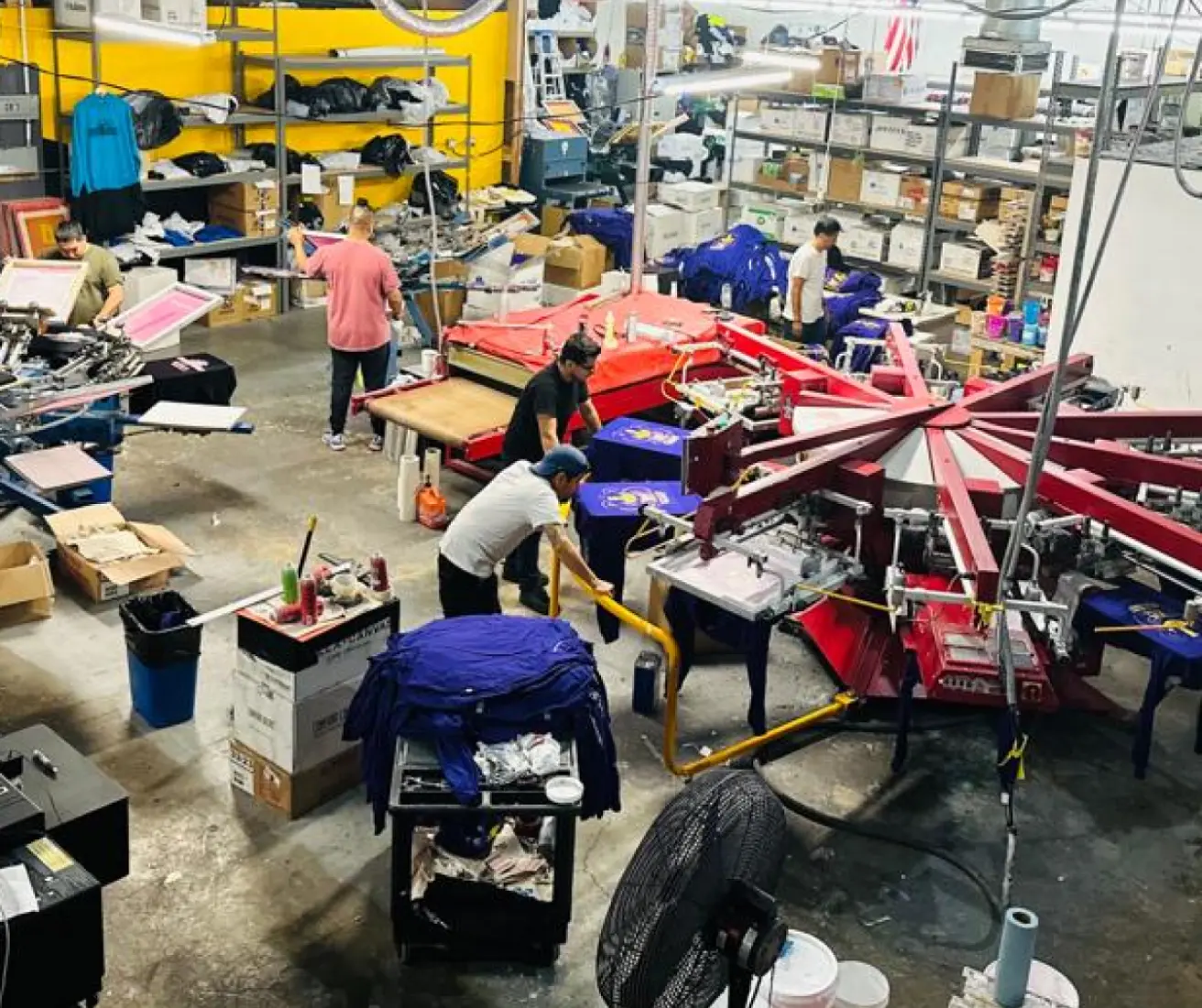Complete Screen Printing Kit for Artists and Creators
Complete Screen Printing Kit for Artists and Creators
Blog Article
Screen Printing Uncovered: Whatever You Required to Know Concerning T-Shirt and Garment Printing Techniques
If you've ever questioned just how those vivid layouts wind up on your favored tees, you remain in the appropriate area. Display printing is a remarkable method that combines art with technique, offering endless opportunities for creative thinking. Recognizing the principles, from devices to ink choices, can considerably affect your results. All set to discover the necessary elements that make screen printing an art form? Allow's uncover the details that can elevate your projects.
The Basics of Display Printing: Exactly How It Functions
When you dive into display printing, you'll find it's both a scientific research and an art. At its core, display printing involves developing a stencil, or screen, that allows ink to travel through just in particular locations (screen printing kit). You begin by selecting your design and preparing your display with a light-sensitive emulsion. Once you expose this solution to light, it solidifies, leaving your layout as an adverse area.
Next, you'll mix your inks and prepare your printing surface. Placement the screen over the textile, then make use of a squeegee to push ink via the display onto the garment. This process needs accuracy, as you want clear, dynamic prints. After printing, you'll cure the ink with warm, guaranteeing it abides by the textile and lasts via cleans. Each action is essential, and grasping them will certainly boost your display printing abilities, transforming basic garments into distinct, expressive pieces.
Sorts Of Screen Printing Methods
When you realize the basics of screen printing, it's time to explore the numerous strategies that can boost your styles. One popular method is standard screen printing, where ink is pressed via a stenciled display. This method is excellent for strong, vivid shades. After that there's water-based ink printing, which supplies a softer feeling and is environmentally friendly, however it requires a different strategy to healing.
One more alternative is plastisol printing, understood for its toughness and brilliant shades, making it a preferred for many brands. Experiment with halftone printing to create slope results and elaborate layouts.
Vital Equipment for Screen Printing
To achieve spectacular cause screen printing, having the appropriate tools is essential. You'll need a strong display printing structure, which holds the mesh that transfers your style onto the garment. Next off, buy high-grade mops; these are crucial for using ink evenly throughout the screen. You'll also need an excellent direct exposure unit to create your screens, along with a washout cubicle for cleansing them after usage. A reputable heat source, like a conveyor dryer or warm press, is essential for healing your prints to ensure long life. Do not neglect a correct work area, equipped with tables and storage for your supplies. Protective gear, such as masks and gloves, will certainly keep you safe from chemicals and inks. With the right tools, you'll be well on your method to creating professional-quality prints.
Selecting the Right Inks and Materials
When selecting inks and products for screen printing, you require to take right into account the kind of ink that functions finest for your job. Believe about fabric compatibility to guarantee your designs look excellent and last long. Likewise, check out green ink alternatives to make your printing procedure much more sustainable.
Sorts Of Screen Inks
Selecting the right display ink is crucial for accomplishing vibrant, long lasting prints that fulfill your task's demands. There are several types of screen inks to examine. Specialty inks, such as glow-in-the-dark or metal, can add unique effects to your designs.

Material Compatibility Considerations
Understanding fabric compatibility is important for attaining high-quality display prints, particularly given that different materials react distinctly to numerous inks. When choosing inks, take into consideration the material kind-- cotton, polyester, or blends. For cotton, water-based inks work well, providing softness and breathability. Polyester, on the other hand, usually requires plastisol inks for much better bond and vivid colors. You might need to utilize a mix of both types if you're printing on blends. Constantly examine your inks on example textile to assure they stick effectively and keep shade honesty. In addition, bear in mind that material weight and structure can influence the last result, so choosing the ideal ink and product combo is important for your project's success.
Eco-Friendly Ink Options
Environmentally friendly inks are ending up being a prominent selection for screen printers who want to lessen their environmental influence while keeping high quality. When choosing inks, consider water-based inks, which are less damaging and simpler to cleanse up contrasted to standard solvents.
In addition, search for inks made from renewable energies, such as soy or vegetable-based alternatives. By picking the right inks and products, you'll not only produce spectacular designs however likewise add to a more lasting printing process. Make the button, and your prints will mirror your commitment to the environment!
Preparing Your Layout for Screen Printing

Submit Format Demands
To assure your layout looks vibrant and sharp on fabric, you'll require to pay close attention to file layout needs for screen printing. Start with vector files like AI or EPS, as they can be scaled without shedding quality. If you use raster pictures, select high-resolution data, such as TIFF or PNG, preferably at 300 DPI. Avoid utilizing JPEGs, as they can shed quality when resized. Also, make sure your style has a transparent background to protect against unwanted white edges on your prints. Maintain shade settings in mind; CMYK is standard for screen printing, so convert your RGB makes appropriately - screen printing kit. By complying with these guidelines, you'll set your artwork up for a successful print.
Color Separation Techniques
Color splitting up is an essential action in preparing your design for display printing, and mastering it can substantially improve your print quality. You'll require to break your layout right into specific colors, as each shade needs a different display during printing. This accuracy not only ensures accurate color depiction yet likewise enhances the printing procedure.
Resolution and Size
Accomplishing the very best lead to screen printing starts with assuring your design has the ideal resolution and size. Ideally, your art work should be at least 300 DPI (dots per inch) for sharp, clear prints. Your last item might look pixelated and less than professional. if you use reduced resolution.
When it comes to size, take into consideration the measurements of your print area. Design your art work to match the last print size, ideally producing it in the actual measurements you'll be printing. This method, you'll prevent any kind of unexpected scaling problems.
Always check your style in both vector and raster formats. Vector graphics can be scaled without shedding high quality, making them perfect for screen printing. Preparing properly will assure your layout looks amazing on every garment!
Step-by-Step Screen Printing Process
Screen printing is a vibrant procedure that permits you to produce vivid layouts on numerous surfaces. To get going, you'll need a screen, emulsion, and your picked ink. First, prepare your display by cleansing it thoroughly. Next off, apply the emulsion evenly and allow it completely dry in a dark location. As soon as dry, expose your display to light with your layout positioned on it, which will certainly solidify the solution where the light hits, producing a stencil - screen printing kit.
Put ink onto the display and use a squeegee to push the ink with the pattern onto the material. Raise the screen carefully and allow the print completely dry. You've effectively screen published your design.
Tips for Effective Screen Printing Projects
While you're diving right into your screen printing tasks, keep in mind that preparation is vital to success. Start by collecting all your materials-- inks, garments, displays, and mops. A tidy office helps protect against undesirable mistakes, so clean up prior to you start.
Following, validate your artwork is high-resolution and effectively sized for your garment. Evaluate your display for proper exposure and tidy it thoroughly to prevent spots. When mixing your inks, follow the maker's guidelines to achieve the ideal uniformity.
During printing, apply even stress with your squeegee for consistent outcomes. Do not rush; take your time to confirm each print fulfills your standards. After printing, let your garments dry entirely before managing or packaging them.
Last but not least, always keep an example of your help future reference. By doing this, you can analyze your progress and enhance your strategies over time. Pleased printing!

Often Asked Concerns
For how long Does It Require To Establish a Display Printing Work?
Establishing a screen printing job typically takes about 30 minutes to an hour. You'll prepare the displays, mix inks, and readjust the press. The time differs based upon intricacy and experience, so remain organized!
Can I Publish on Different Fabric Keys In Using the Same Strategy?
Yes, you can print on various textile silk screen printing types using the same strategy, however you'll need to readjust your settings and inks. Some fabrics take in ink in different ways, so exploring guarantees the very best results for each and every product.
What Are Common Blunders to Prevent in Display Printing?
When screen printing, stay clear of typical mistakes like utilizing the wrong ink, disregarding appropriate exposure times, or avoiding pre-press checks. Always check your setup and keep clean screens to guarantee top quality outcomes each time.
Just How Can I Effectively Clean and Preserve My Screen Printing Devices?
To effectively clean and keep your screen printing tools, you should frequently wash screens with suitable solvents, check mops for wear, and guarantee all devices are kept dust-free and dry. Uniformity enhances and avoids pricey repairs performance.
Is Display Printing Environmentally Pleasant Contrasted to Other Techniques?
Display printing can be more eco-friendly than other techniques, especially if you use water-based inks and eco-conscious products. By selecting lasting supplies and practices, you decrease waste and lessen your influence on the world.
Display Printing Uncovered: Everything You Need to Know About Tee Shirt and Garment Printing Methods
At its core, display printing includes producing a pattern, or display, that allows ink to pass with just in certain locations. Placement the display over the textile, after that make use of a squeegee to push ink via the display onto the garment. One preferred approach is typical display printing, where ink is pressed through a stenciled screen.When choosing inks and materials for screen printing, you need to take into account the kind of ink that functions best for your task.
Report this page